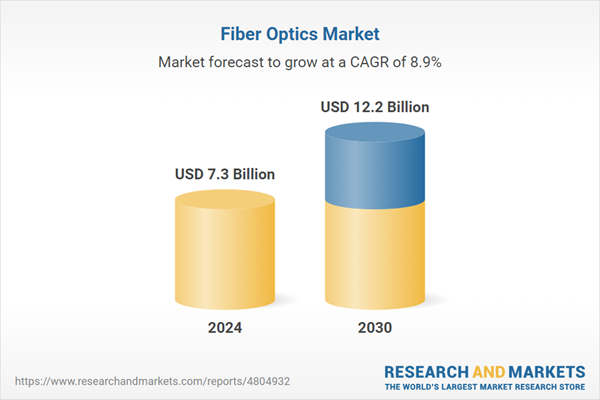The global market for Fiber Optics was valued at US$7.3 Billion in 2024 and is projected to reach US$12.2 Billion by 2030, growing at a CAGR of 8.9% from 2024 to 2030. This comprehensive report provides an in-depth analysis of market trends, drivers, and forecasts, helping you make informed business decisions.
Fiber optics have a wide range of applications across various industries. In telecommunications, they form the backbone of the internet, enabling high-speed broadband connections and supporting the ever-growing demand for data. The capacity of fiber optics to handle vast amounts of data at incredible speeds makes them indispensable for modern internet services, including streaming, video conferencing, and online gaming. In the medical field, fiber optics are utilized in endoscopy and minimally invasive surgeries, providing high-resolution images from inside the body. These applications improve diagnostic accuracy and patient outcomes while reducing recovery times and the invasiveness of procedures. The technology is also pivotal in military and aerospace applications, where it is used for secure communications and advanced sensor systems, ensuring reliable and encrypted data transfer in mission-critical operations. Additionally, the entertainment industry leverages fiber optics for high-quality audio and video transmission, enhancing consumer experiences in broadcasting and home entertainment. Fiber optics enable the distribution of high-definition content to multiple devices without degradation in quality, supporting the growth of home theaters and on-demand services. Industrial automation, smart grid energy systems, and data centers also rely heavily on fiber optic networks for efficient and reliable operations. In these settings, fiber optics support the real-time monitoring and control of systems, enhancing productivity and energy efficiency.
The growth in the fiber optics market is driven by several factors, including the exponential increase in data consumption and the proliferation of internet-connected devices. With the number of devices connected to the internet rising rapidly, the need for high-speed, high-capacity data transmission is greater than ever. The advent of 5G technology and the expansion of cloud computing services necessitate the deployment of extensive fiber optic infrastructure to support higher data rates and low latency requirements. 5G networks rely on dense fiber optic networks to connect base stations and handle the massive data throughput generated by advanced mobile applications and services. Additionally, the push for smart cities and the Internet of Things (IoT) is accelerating the demand for robust and high-capacity communication networks, further propelling market growth. Smart city initiatives involve the integration of various technologies to improve urban living, requiring reliable and high-speed networks for applications such as traffic management, energy distribution, and public safety. The rise in telehealth services and remote work has also emphasized the need for reliable and high-speed internet connections, driving investments in fiber optic networks. Telehealth relies on high-quality video consultations and the transfer of large medical files, which are best supported by fiber optics. Remote work demands stable and fast internet connections for video conferencing, collaborative platforms, and data access. Moreover, government initiatives and funding aimed at bridging the digital divide and enhancing broadband access in rural and underserved areas are significant growth drivers in the fiber optics market. Programs to extend high-speed internet access to remote regions ensure that all communities can benefit from digital services, education, and economic opportunities. These factors collectively contribute to the expanding adoption and advancement of fiber optic technologies globally, paving the way for continued innovation and connectivity enhancements.
Global Fiber Optics Market - Key Trends & Drivers Summarized
Fiber optics, the technology that uses thin strands of glass or plastic fibers to transmit data as light signals, has revolutionized telecommunications and networking. Developed in the 1970s, fiber optic cables offer significantly higher bandwidth and faster data transmission speeds compared to traditional copper wires. These cables function by transmitting data through light pulses generated by lasers or LEDs, which travel through the core of the fiber by the principle of total internal reflection. This ensures minimal signal loss and allows for long-distance data transmission without the need for signal boosters. With their immunity to electromagnetic interference, fiber optic systems are also more reliable and secure, making them an ideal choice for critical infrastructure and communication networks. Additionally, the small size and lightweight nature of fiber optic cables make them easier to install and handle, reducing infrastructure costs and physical space requirements in dense urban environments.Fiber optics have a wide range of applications across various industries. In telecommunications, they form the backbone of the internet, enabling high-speed broadband connections and supporting the ever-growing demand for data. The capacity of fiber optics to handle vast amounts of data at incredible speeds makes them indispensable for modern internet services, including streaming, video conferencing, and online gaming. In the medical field, fiber optics are utilized in endoscopy and minimally invasive surgeries, providing high-resolution images from inside the body. These applications improve diagnostic accuracy and patient outcomes while reducing recovery times and the invasiveness of procedures. The technology is also pivotal in military and aerospace applications, where it is used for secure communications and advanced sensor systems, ensuring reliable and encrypted data transfer in mission-critical operations. Additionally, the entertainment industry leverages fiber optics for high-quality audio and video transmission, enhancing consumer experiences in broadcasting and home entertainment. Fiber optics enable the distribution of high-definition content to multiple devices without degradation in quality, supporting the growth of home theaters and on-demand services. Industrial automation, smart grid energy systems, and data centers also rely heavily on fiber optic networks for efficient and reliable operations. In these settings, fiber optics support the real-time monitoring and control of systems, enhancing productivity and energy efficiency.
The growth in the fiber optics market is driven by several factors, including the exponential increase in data consumption and the proliferation of internet-connected devices. With the number of devices connected to the internet rising rapidly, the need for high-speed, high-capacity data transmission is greater than ever. The advent of 5G technology and the expansion of cloud computing services necessitate the deployment of extensive fiber optic infrastructure to support higher data rates and low latency requirements. 5G networks rely on dense fiber optic networks to connect base stations and handle the massive data throughput generated by advanced mobile applications and services. Additionally, the push for smart cities and the Internet of Things (IoT) is accelerating the demand for robust and high-capacity communication networks, further propelling market growth. Smart city initiatives involve the integration of various technologies to improve urban living, requiring reliable and high-speed networks for applications such as traffic management, energy distribution, and public safety. The rise in telehealth services and remote work has also emphasized the need for reliable and high-speed internet connections, driving investments in fiber optic networks. Telehealth relies on high-quality video consultations and the transfer of large medical files, which are best supported by fiber optics. Remote work demands stable and fast internet connections for video conferencing, collaborative platforms, and data access. Moreover, government initiatives and funding aimed at bridging the digital divide and enhancing broadband access in rural and underserved areas are significant growth drivers in the fiber optics market. Programs to extend high-speed internet access to remote regions ensure that all communities can benefit from digital services, education, and economic opportunities. These factors collectively contribute to the expanding adoption and advancement of fiber optic technologies globally, paving the way for continued innovation and connectivity enhancements.
Scope of the Study
The report analyzes the Fiber Optics market, presented in terms of market value (US$ Thousand). The analysis covers the key segments and geographic regions outlined below.Segments:
Cable Type (Single mode, Multi-mode); Fiber Type (Glass Optical Fiber, Plastics Optical Fiber); Application (Communication, Non-Communication).Geographic Regions/Countries:
World; USA; Canada; Japan; China; Europe; France; Germany; Italy; UK; Spain; Russia; Rest of Europe; Asia-Pacific; Australia; India; South Korea; Rest of Asia-Pacific; Latin America; Argentina; Brazil; Mexico; Rest of Latin America; Middle East; Iran; Israel; Saudi Arabia; UAE; Rest of Middle East; Africa.Key Insights:
- Market Growth: Understand the significant growth trajectory of the Single Mode Fiber Optic Cable segment, which is expected to reach US$9.4 Billion by 2030 with a CAGR of a 9.0%. The Multi Mode Fiber Optic Cable segment is also set to grow at 8.5% CAGR over the analysis period.
- Regional Analysis: Gain insights into the U.S. market, valued at $906.5 Million in 2024, and China, forecasted to grow at an impressive 10.3% CAGR to reach $3.4 Billion by 2030. Discover growth trends in other key regions, including Japan, Canada, Germany, and the Asia-Pacific.
Report Features:
- Comprehensive Market Data: Independent analysis of annual sales and market forecasts in US$ Million from 2024 to 2030.
- In-Depth Regional Analysis: Detailed insights into key markets, including the U.S., China, Japan, Canada, Europe, Asia-Pacific, Latin America, Middle East, and Africa.
- Company Profiles: Coverage of major players such as AFL Telecommunications, LLC, Anixter Inc, Belden Inc., Corning Inc., Prysmian Cables & Systems Ltd. and more.
- Complimentary Updates: Receive free report updates for one year to keep you informed of the latest market developments.
Why You Should Buy This Report:
- Detailed Market Analysis: Access a thorough analysis of the Global Fiber Optics Market, covering all major geographic regions and market segments.
- Competitive Insights: Get an overview of the competitive landscape, including the market presence of major players across different geographies.
- Future Trends and Drivers: Understand the key trends and drivers shaping the future of the Global Fiber Optics Market.
- Actionable Insights: Benefit from actionable insights that can help you identify new revenue opportunities and make strategic business decisions.
Key Questions Answered:
- How is the Global Fiber Optics Market expected to evolve by 2030?
- What are the main drivers and restraints affecting the market?
- Which market segments will grow the most over the forecast period?
- How will market shares for different regions and segments change by 2030?
- Who are the leading players in the market, and what are their prospects?
Some of the 95 major companies featured in this Fiber Optics market report include:
- AFL Telecommunications, LLC
- Anixter Inc
- Belden Inc.
- Corning Inc.
- Prysmian Cables & Systems Ltd.
- Geokon Inc.
- Fujikura Ltd.
- Leoni AG
- Finolex Cables Ltd.
- Yangtze Optical Fiber & Cable Joint Stock Limited Company
Table of Contents
I. METHODOLOGYMII. EXECUTIVE SUMMARY2. FOCUS ON SELECT PLAYERSIII. MARKET ANALYSISCANADAITALYSPAINRUSSIAREST OF EUROPESOUTH KOREAREST OF ASIA-PACIFICARGENTINABRAZILMEXICOREST OF LATIN AMERICAIV. COMPETITION
1. MARKET OVERVIEW
3. MARKET TRENDS & DRIVERS
4. GLOBAL MARKET PERSPECTIVE
UNITED STATES
JAPAN
CHINA
EUROPE
FRANCE
GERMANY
UNITED KINGDOM
ASIA-PACIFIC
AUSTRALIA
INDIA
LATIN AMERICA
MIDDLE EAST
AFRICA
Companies Mentioned (Partial List)
A selection of companies mentioned in this report includes, but is not limited to:
- AFL Telecommunications, LLC
- Anixter Inc
- Belden Inc.
- Corning Inc.
- Prysmian Cables & Systems Ltd.
- Geokon Inc.
- Fujikura Ltd.
- Leoni AG
- Finolex Cables Ltd.
- Yangtze Optical Fiber & Cable Joint Stock Limited Company
Table Information
| Report Attribute | Details |
|---|---|
| No. of Pages | 546 |
| Published | March 2025 |
| Forecast Period | 2024 - 2030 |
| Estimated Market Value ( USD | $ 7.3 Billion |
| Forecasted Market Value ( USD | $ 12.2 Billion |
| Compound Annual Growth Rate | 8.9% |
| Regions Covered | Global |









